Five QR code strategies for newspapers
Part Two of this report on QR Codes look at examples at how print publications around the country are using QR Codes to enhance editorial and advertising. Many local media companies interviewed consider their QR Code strategies "missionary" and see a benefit in being positioned as "cutting edge" by introducing them to the market. However, four key strategies are emerging, each of which is exemplified by one or more of these case studies, three of which have revenues attached in the $100,000 to $1 million range, including the additional media buys involved.
a. Print-to-mobile interactivity for editorial, especially for adding rich content
b. Print-to-mobile interactivity for advertising campaigns, especially for offers and additional information. This includes both indivitual advertising campaigns, and increasingly vertical pages such as real estate and auto.
c. Print-to-text back marketing to build advertisers' opt-in lists
d. Group ads for print-to-mobile coupons which bundle print/coupons and other digital products such as e-mail.
Keeping in mind that only 6% of the mobile market has scanned a QR code, (see "Pros and Cons, plus do's and don'ts, of using QR Codes here), print is still the easiest way to use codes, which instantly "mobilize" an ad. The biggest hurdle is getting consumers to download the app that reads codes, so significant contests that help grow this market is a good idea, especially in small markets.
1. The QR Code Special Issue
Media: C-ville, a 23 yearold weekly, and C-ville.com
Market: Charlottesville, Virginia
Initiative: The QR Code Special Issue
Key Executive: Frank Dubec, Group Publisher
Placing QR Codes on advertising campaigns is still new. So C-Ville weekly created a QR Codes issue to help educate the marketplace - both advertisers and consumers, "be the first to introduce them in the market" and drive revenues. They created a special issue in which (almost all) of the advertisers had QR codes, combined with an editorial contest - this was an issue with a cover story on bike riding - in which people who scanned the code were entered to win a bicycle. The contest helped enlarge the market for QR Code users, and thus also helping advertisers in the issue.
Below is the cover story, with the contest and QR code printed on the cover:

"It was the first introduction of QR Codes to this market," says Dubec.
"We were doing missionary work, calling our clients and saying, heh, it’s the latest and greatest and make your print ad more actionable and transactionable."
C-ville created the codes, linked to incentives and offers, plus a full page ad and online video explaining "This is a QR code" and how it works:
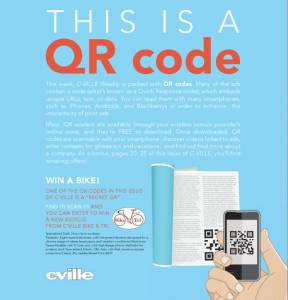
Results: Analytics were not tracked, however there were 40 new ads sold and a 30% increase in revenues for that issue. In addition, ads with QR codes continue to run.
"We didn’t change the world with it, but it was a good story to bring to clients and readers. Experientially on the readers side it was engaging, and on the client front, we had the newest thing. A good step forward, especially in this market.”
2. Enhancing editorial with multi-media content
Media: North Bay Bohemian, an alternative weekly newspaper
Market: Santa Rosa, Napa and Sonoma, California
Initiative: Best of Issue with additional video content
Key executive: Gabe Meline, editor
As written up on the AAN.org web site, the North Bay Bohemian decided to launch the cutting edge codes as a theme in its "Best of" issue.
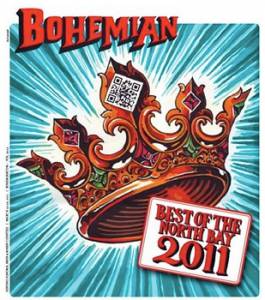 R
R
Rather than focusing on advertisers, the codes were "placed within the text body of local profiles," accessing video. The "2-4 minute videos offer a more dynamic look at the profiles’ subjects, including a feed store, a wedding singer, a restaurant, a camera shop, a local arts venue and more." From the AAN.org article:
“Everyone who’s seen it has said the same thing: ‘This would be terrific for marketing,’” says Meline. “But I’m proud that we used it for editorial. It was remarkably easy, and has generated a lot of interest.”
...The issue’s theme, “Hidden Gems,” refers to both the editorial The QR code on the cover leads to a landing page, coded in-house, upon which the reader can automatically “like” the North Bay Bohemian on Facebook by tapping an icon. Another link leads to the Bohemian’s site.
3. Print-to-mobile group program generates $100,000 plus
Company: Arizona Daily Star
Initiative: Green Tag Tuesdays
Key executive: John Humenik, President and Publisher; Chase Renkin, Advertising Director
A number of local media are bundling QR codes on small group ads, such as coupons, real estate and even auto. The Arizona Star's Green Tag Tuesdays, itself borrowed from Red Tag program in Billings Montana uses QR codes for people to access weekly discounts, mobiley.
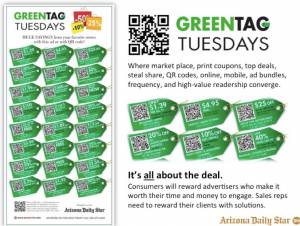
Every Tuesday, a page of QR codes entitled "Green Tag Tuesday" runs in the paper. The "tags" include an offer, merchant contact information, and a QR code that scans to a mobile landing page with click-to-call and a map. There are exactly 24 codes in an easy to manage, templated page, so the limited inventory gives program sales urgency and helps sell it out.
Technology
The company's programers created codes directly via Google; when a new offer is created the URL is entered into Google, the url, whose API returns the code back. However this is unecessary - QR codes are free or almost free (a top pick, QRstuff.com costs about $86 a year including analytics, which we highly recommend). Burns said the Google interface only required about 12 hours of programming. Each merchant can also place their ad - and the green tag - directly via their mobile phone, and is issued a QR code automatcially.
Sales reps have access to a dashboard to type their own offers, and can also bill the client from their mobile phone.
Bundling
Pricing for the scannable codes started out with Best of Winners getting two months free, otherwise advertisers paid $50 a week for the service. However the program is primarily sold in bundles: four insertions in the paper in 7 days, including Sunday, GreenTag Tuesdays and plus 30,000 impressions. Good, better, best packages merely vary the size of the ad and number of impressions.
Like daily deals, Humenik says, "The key is the deal, first thing(reps) are doing is working with their clients to find great deals....the best part is our staff is understanding bundling."
Also real estate ads
Real estate ads in the Arizona Star are limited by size, "there is only so much you can put in one ad," Renkin says. Now the Arizona Star puts QR codes on its 2x3 inch real estate ads. "People can scan on the property and see the pool." Scanning the shows a mobile profile of the home with all the information. Since including codes, the average home recieves about average 7 scans per homes. Renkins says realtors love the program. He is rolling out next to automotive advertising.
Company: North Jersey Media Group
Properties: The Record, Herald News, NorthJersey.com
Traffic: 1.3 Million UV's monthly
Initiative: QR codes with SMS
Key Executive: Brian Burns, VP of Digital
Challenge: To allow merchants to use QR codes on ads to drive text-based promotions and long term customer loyalty programs.
Strategy: SMS campaigns, employing QR codes allow people the option of scanning, instead of texting to a short code associated with a deal or enter to win promotion. The advertiser gets the advantage of the opt-in list, and building this list provides a reason for continued advertising. Unlike some of the programs we've seen, this one is unique in that the QR Code does not go to, say, an enter-to-win web page, but triggers an automated text back.
Like many of these early efforts, a significant contest always helps to expand the market for QR code users while driving the opt-in list.
As an example, for a local electronics store that advertises a number of price-items, a Scan (or textback) to win a Flatscreen can be added to the campaign, helping build the opt-in list.
In this case the promotion might read "Scan to win or Text Flatscreen to 5555." The scan produces an automated text message, ie "Thanks for contacting Mr. Electronics. Text "Flatscreen" to 55555 to enter to win a free flatscreen television. Reply "stop" to stop all future messages.
b. Finding the short code. Burns used Dallas-based Fulcrum Mobile, which is both a short code aggregator and also provides SMS services. If your company has a development staff, it may also be possible to acquire a short code (like a URL but more expensive and slightly more complicated to purchase) at usshortcodes.com, or use one supplied by the SMS partner.
c. Integrating with SMS. There are a variety of companies like Fulcrum that supply some or all of the integration needed to provide this service. Another company LMI recommends, Textmunication, will acquire a short code for you, or allow use of theirs, generate QR code to text-messages, and includes both a dashboard for the media company and a white label interface for merchants. They work on a revenue share, based on their own pricing, that is, the media company can resell SMS services for the same prices that Textmunication offers to merchants. Look for these capabilities when selecting a vendor.
Results The open rates of text - roughly 98% is much higher than email, and thus, so is the perceived value to merchants. Burns says the responses to campaigns has been "incredible" and that these campaigns average in the $2000 to $20000 a month range. The Houston Chronicle is also reporting significant print upsells from its SMS programs.
5. QR code with print/blog/video package generates $1 million in sales
Ten community newspapers in Ontario sold out 15 advertisers each to annual print with QR code-to-video profile, plus a blog on their new "ShopTalk" websites. Each advertiser signed a one year commitment to be one of the first 15 merchants on the new site; including a 60 second video, a blog, and 12 1/4 ads placed once a month on group pages. Because this is a complicated - but high revenue project - please find the full case study on exactly how they created and sold the program here.
The top half of each "ShopTalk" site is all video, with advertisers rotating in to the key position:
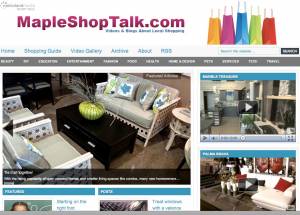
Below the fold are the "blogs" that are part of the package:
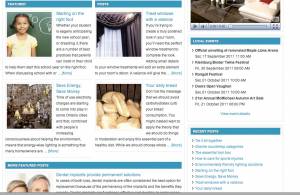
A number of smaller initiatives like this are underway, most using some kind of guide or directory platform to host the video profiles, but leaving out the blogging component. The value of these bundles which offer merchants a huge value, is not really in the QR Code itself, but in its ability to tie print ads to video profiles, and thus create an annual contracts from otherwise small advertisers.
Conclusions
QR is good for print
Print lends itself to QR Codes much more naturally than broadcast does, and the variety of uses for QR codes with print is becoming more apparent as local companies experiment. A number of initiatives not mentioned in this report are in the development stages and primarily involved print-to-mobile coupon programs, similar to GreenTag Tuesdays, but with a variety of local spins.
Expect only a small - but important- increase in conversions
The most important thing to remember when using QR Codes is how narrow the current adoption still is - only 6% of mobile users. See "Pros and Cons of Using QR Codes" for the rundown on this. So the concept of introducing QR Codes to the market while launching other programs is important. Think in terms of including information (via links to instructions or video) on how to use a QR Code, having an All QR code issue, or really big contests in which new scanners are rewarded in interesting ways for jumping through the hoop. However, for high ROI sales such as auto and real estate, and average of just seven extra scans a week per ad is significant.
Important trends toward video and bundling
Finally, there is an evolving trend towards scan-to-video applications for QR Code technology that is worth mentioning. Users strongly prefer accessing a mobile video to just about any other kind of application. Think about, for example, print-to-video for a dining guide, in which the print version includes codes that access video profiles of the restaurant. Helpful to a diner who is new in town? We think so. Our next case study will feature a sophisticated bundle of print-to-video and blog.
Additionally, while television companies have more difficulties in understanding how to use QR Codes, one simple way is forbroadcast sites to buy print to drive traffic interactively to their own video programing such as news or sports. When forming alliances with broadcast companies - or acquiring syndicated video content - something to keep in mind.
The larger the number of ongoing codes, the more important the QR code vendor
Don't put your company in a situation with hundreds or thousands of QR codes used for ongoing programs (directories, video guides, and so on) only to have the vendor go out of business. Because QR codes are new and mostly free there is bound to be some shake out so choose wisely. Many providers also offer analytics, mobile web pages, URL shortening so that the url matched with the code can be changed, SMS and other kinds of services.
Resources: A few vendors used by LMI members include QRStuff.com; Vendasta.com (used by Metroland) and Sparqcode (QR code and mobile landing page-building). For video editing-to-mobile page Affinity Express is used by JRC.
Update: LMI member notes that Half Off Deals now uses a QR code on our customer printed (print on demand) certificate for merchant redemption, ie merchants can now scan the QR code on the printed gift certificates to validate the certificate using any smart phone.

The author, Alisa Cromer is publisher of a variety of online media, including LocalMediaInsider and MediaExecsTech, developed while on a fellowship with the Reynolds Journalism Institute and which has evolved into a leading marketing company for media technology start-ups. In 2017 she founded Worldstir.com, an online magazine, to showcases perspectives from around the world on new topic each month, translated from and to the top five languages in the world.






